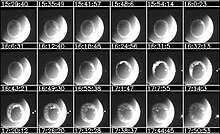Partial magnetospheric storm

A substorm (English [magnetospheric] substorm is) a momentary disturbance in the magnetosphere a planet causes the release and redirection of energy from the "tail" of the magnetosphere in the near-polar ionosphere. Visually, it appears as a sudden lighting up and increased movement of aurora arcs. The Norwegian scientist Kristian Birkeland first described partial storms as “polar elementary storms”. Sydney Chapman used the term “substorm” around 1960, which is now the standard term. The morphology of a partial storm was first described by the Japanese geophysicist Syun-Ichi Akasofu in 1964 on the basis of data from the International Geophysical Year .
Partial storms differ from magnetic storms in that the latter last for days, can be observed all over the planet, initiate large numbers of ions into the Van Allen outer radiation belt, and once or twice a month during peak solar wind activity, and few during low periods Occur times a year. Partial storms, on the other hand, occur over a period of a few hours, are mainly observed in the polar region , introduce few particles into the radiation belt and are relatively frequent, often only a few hours apart. Partial storms accumulate during a geomagnetic storm, often overlapping with subsequent ones. The source of the magnetic disturbances observable on the surface during magnetic storms is the ring current , with partial storms it is electrical currents in the near-pole ionosphere .
Partial storms can cause magnetic field disturbances in the polar zones up to field strengths of around 1000 nanotesla , about 2% of the total field strength in these regions. The disturbance is much stronger in space, where some geosynchronous satellites have detected drops to half the field strength. The most visible signs of a partial storm are intensified and extended northern lights. Partial storms occur about six times a day, with more frequent and stronger occurrences during a geomagnetic storm. Three phases are described: build-up, expansion and recovery.
In 2012, the THEMIS mission observed the dynamics of a rapidly developing partial storm and confirmed the existence of huge magnetic ribbons and witnessed small explosions in the outer areas of the terrestrial magnetic field.
swell
- ^ Kristian Birkeland: The Norwegian Aurora Polaris Expedition 1902-1903 . H. Aschehoug & Co, New York and Christiania (now Oslo) 1908 (section 1), 1913 (section 2). out of print, full text online
- ↑ Sarris, T. and Li, X .: Evolution of the dispersionless injection boundary associated with substorms . In: Annales Geophysicae . 23, March 30, 2005, pp. 877-884. bibcode : 2005AnGeo..23..877S . doi : 10.5194 / angeo-23-877-2005 .
- ↑ Syun-Ichi Akasofu: The development of the auroral substorm . In: Planetary and Space Science . 12, No. 4, April 1964, pp. 273-282. bibcode : 1964P & SS ... 12..273A . doi : 10.1016 / 0032-0633 (64) 90151-5 .
- ↑ T. Potemra: Magnetospheric substorms . American Geophysical Union, Washington, DC 1991, ISBN 0-87590-030-5 , p. 488.
- ↑ a b Stern, David P. and Peredo, Mauricio: Substorms . November 25, 2001. Retrieved March 21, 2010.
- ↑ substorm . Southwest Research Institute. Retrieved March 24, 2010.
- ^ " NASA Spacecraft Make New Discoveries About Northern Lights "
